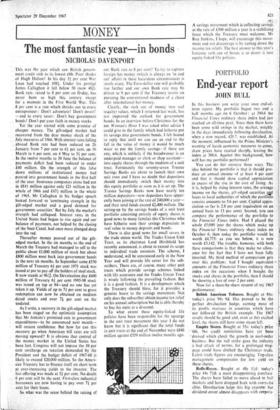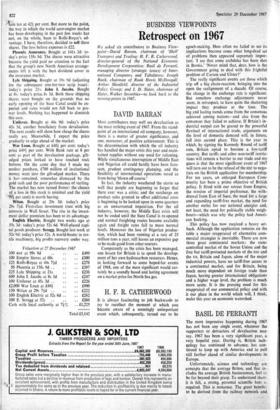End-year report
PORTFOLIO JOHN BULL
In this business you write your own end-of- term report. My portfolio began two and a half months ago on 6 October : at 390,6 the Financial Times ordinary share index had just reached an all-time peak. Since then there have been some wild swings in the market, notably in the days immediately following devaluation, when a new record, 420.7, was established. At the moment, influenced by the Prime Minister's warning of harsh economic measures to come, share prices have reacted sharply, leaving the index at 388.6. Against this background, how well has my portfolio performed?
You can do this exercise three ways. The idea behind the portfolio is that it should pro- duce an annual income of at least 4 per cent and that it should show capital appreciation in excess of the rise in the cost of living. As it is, helped by rising interest rates, the average income on the shares, gilt-edged securities AW loans to local authorities of which the porttlAo consists amounts to 5.6 per cent. Capital appre- ciation so far is 2.8 per cent (equivalent on an annual basis to 13 per cent). Second, you can compare the performance of the portfolio to the Financial Times index. Had I placed the whole £5,000 into the shares which make up the Financial Times ordinary share index on October 6, then today the portfolio would be worth £4,775: as you see below, it is now worth £5,142. The trouble, however, with both these comparisons is that they make no allow- ance for the fact that I have not been fully invested. My third method of comparison gets over this problem : had I bought equivalent amounts of the Financial Times ordinary share index on the occasions when I bought the stocks and shares in the portfolio, then I should be showing a loss of over 2 per cent.
Now for a share-by-share resume of my 1967 performance:
British American Tobacco. Bought at 84s: today's price 99s 9d. Has proved to be the perfect devaluation hedge, earning most of - its profits overseas in countries which have 'not followed the British example. The 1967 results should be good and, even at this exalted level, the shares still have some steam left.
Empire Stores. Bought at 55s: today's price 160s. No credit restrictions have yet been "devised which check the growth in mail-order business. But the rail strike gave the industry a bad attack of nerves, for a prolonged stop- page could have ditched the Christmas trade. Latest trade figures are encouraging. Top-class management compensates for low yield on these shares.
Rolls-Royce. Bought at 48s lid: today's price 44s 71d; a most disappointing purchase The shares have failed to move ahead in bull markets and have dropped back with every.41, cline. Devaluation helps this big exporter but
• dividend cover almost disappears with corpora- %1Jain tax at 421 per cent. But more to the point, the way in which the world aero-engine market has been developing in the past few weeks has not, on the whole, been to Rolls-Royce's ad- vantage. I have, therefore, decided to sell these shares. The loss before expenses is £22.
Phoenix Assurance. Bought at 141s 3d: to- day's price 158s 9d. The shares were attractive because the yield paid no attention to the fact that the group's new North American arrange- ments left it with the best dividend cover in the insurance market.
Lyle Shipping. Bought at 19s 9d (adjusting for the subsequent one-for-two scrip issue): today's price 21s. John I. Jacobs. Bought at 8s: today's price._ 8s 3d. Both these shipping shares were bought on the grounds that no early opening of the Suez Canal could be ex- pected and rates would not fall back to pre- war levels. Nothing has happened to diminish this case.
Unilever. Bought at 44s 9d: today's price 45s 3d, another beneficiary from devaluation.
The next results will show how cheap the shares really are. Meanwhile, I expect the price gradually to edge ahead of the market.
War Loan. Bought at £48f per cent: today's price £491 per cent. With Bank rate at 8 per cent as part of the devaluation package, gilt- edged prices looked to have touched rock bottom. On the same day that I made my modest purchase, £700 million of institutional money went into the gilt-edged market. There it has remained, somewhat dismayed by the gold rush and the poor performance of sterling. The market has now turned firmer: the chance of a loss in this stock is minimal and the yield ' kfit per cent) is worth having.
Witan. Bought at 29s 3d: today's price 29s 71d. First-class investment trust with big interests in Wall Street. The rise in the invest- ment dollar premium has been to its advantage. English Electric. Bought two weeks ago at 55s 3d: today's price 52s 6d. Well-placed capi- tal goods producer. Scragg. Bought last week at 52s 9d: today's price 52s. A world-beater in tex- tile machinery, big profits recovery under way.
Valuation at 27 December 1967
100 BAT at 99s 9d .. £499 100 Empire Stores at 60s • • £300 125 Rolls-Royce at 44s 71-d • • £278 50 Phoenix at 158s 9d • • £397 225 Lyle Shipping at 21s • • £236 600 John I. Jacobs at 8s 3d • • • • £247 100 Unilever at 45s 3d .. £226 £2,000 War Loan at £491 . • £990 150 Witan at 29s 71d £222 100 English Electric at 52s 6d .. £262 100 E. Scragg at 52s .. £260 Cash with local authority at 71% .. £1,225











































 Previous page
Previous page